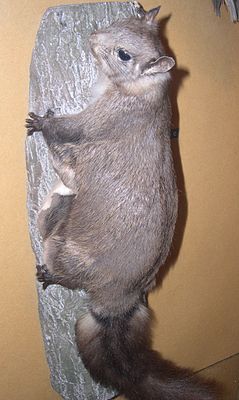Palawan flying squirrel
| Palawan flying squirrel | ||||||||||||
|---|---|---|---|---|---|---|---|---|---|---|---|---|

Palawan flying squirrel ( Hylopetes nigripes ) |
||||||||||||
| Systematics | ||||||||||||
|
||||||||||||
| Scientific name | ||||||||||||
| Hylopetes nigripes | ||||||||||||
| ( Thomas , 1893) |
The Palawan flying squirrel ( Hylopetes nigripes ) is a flying squirrel from the genus of the horseshoe flying squirrel ( Hylopetes ). The species occurs exclusively on the Philippine islands of Palawan and Bancalan .
features
The Palawan flying squirrel reaches a head-trunk length of about 26 to 28 centimeters, a tail length of about 31 centimeters and a weight of about 530 grams. The back color is mottled gray-brown, the throat and the ventral side are white to gray-white. The tail is two-colored with a lighter brown on the top and a darker brown on the underside, the colors blur into each other. The ears are large and thinly haired, they are dark brown in color.
Like all flying squirrels, it has a hairy skin that connects the wrists and ankles and is enlarged by a fold of skin between the hind legs and the base of the tail. The sliding skin is muscular and reinforced at the edge, it can be tensed and relaxed accordingly in order to control the direction of the gliding flight.
distribution
The Palawan flying squirrel occurs exclusively and therefore endemic to the Philippine islands of Palawan and Bancalan .
Way of life
Very little data is available on the way of life of the flying squirrel. The habitat is in the lowlands in tropical to subtropical primary and secondary forest . Like other species, it is arboreal and nocturnal. It lives mainly in old trees and uses tree hollows as a nest space. It is comparatively insensitive to changes in habitat and, above all, selective wood removal.
Systematics
The Palawan flying squirrel is classified as an independent species within the genus of the horseshoe flying squirrel ( Hylopetes ), which contains a total of nine species. The first scientific description under the name Sciuropterus nigripes comes from Oldfield Thomas in 1893 using an individual from the island of Palawan. In 1908 Thomas described the genus Hylopetes and assigned this and other species to it. Another subspecies H. n. Elassodontus was described in 1918 by Wilfred Hudson Osgood .
Two subspecies are distinguished within the species:
- Hylopetes nigripes nigripes ( Thomas , 1893 ) from the island of Palawan
- Hylopetes nigripes elassodontus ( Osgood , 1918 ) from Bancalan Island
Existence, endangerment and protection
The Palawan flying squirrel is comparatively common in its area of distribution, whereby it can be recognized by its characteristic communication sounds. However, due to its comparatively small distribution area of less than 20,000 km 2, it is listed as “near threatened” by the International Union for Conservation of Nature and Natural Resources (IUCN). At the same time, stocks of the species are declining due to logging and the associated deterioration in habitat on the Philippine islands. The loss of habitat through deforestation and the conversion of forests into agricultural areas is regarded as the main source of risk. Occasional hunting as a meat supplier and wild-caught animals for the pet trade are classified as minor influences on the size of the herd.
supporting documents
- ↑ a b c d e Richard W. Thorington Jr., John L. Koprowski, Michael A. Steele: Squirrels of the World. Johns Hopkins University Press, Baltimore MD 2012; Pp. 100-101. ISBN 978-1-4214-0469-1
- ↑ a b c Hylopetes nigripes in the IUCN Red List of Threatened Species 2014.1. Posted by: P. Ong, B. Tabaranza, G. Rosell-Ambal, D. Balete, 2008. Retrieved August 8, 2014.
- ↑ a b c d Don E. Wilson & DeeAnn M. Reeder (eds.): Hylopetes nigripes in Mammal Species of the World. A Taxonomic and Geographic Reference (3rd ed).
- ↑ Oldfield Thomas : Description of a new Sciuropterus from the Philippines. Annals and Magazine of Natural History 12 (67), 1893; Pp. 30-31. ( Digitized version ).
literature
- Richard W. Thorington Jr., John L. Koprowski, Michael A. Steele: Squirrels of the World. Johns Hopkins University Press, Baltimore MD 2012; Pp. 100-101. ISBN 978-1-4214-0469-1
Web links
- Hylopetes nigripes inthe IUCN Red List of Threatened Species 2014.1. Posted by: P. Ong, B. Tabaranza, G. Rosell-Ambal, D. Balete, 2008. Retrieved August 8, 2014.